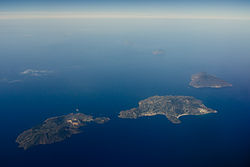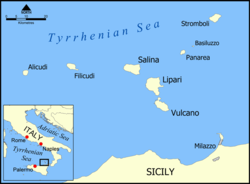Native name: Isole Eolie, Ìsuli Eoli | |
|---|---|
 Aerial view of the Aeolian Islands | |
 Map of the Aeolian Islands | |
| Geography | |
| Location | Tyrrhenian Sea |
| Coordinates | 38°32′N 14°54′E / 38.533°N 14.900°E |
| Area | 114.7 km2 (44.3 sq mi) |
| Administration | |
Italy | |
| Region | Sicily |
| Province | Messina |
| Demographics | |
| Population | 15,419 (1 January 2019) |
| Pop. density | 134.4/km2 (348.1/sq mi) |
| Official name | Isole Eolie (Aeolian Islands) |
| Criteria | Natural: viii |
| Reference | 908 |
| Inscription | 2000 (24th Session) |
| Area | 1,216 ha |
The Aeolian Islands (/iːˈoʊliən/ ee-OH-lee-ən; Italian: Isole Eolie [ˈiːzole eˈɔːlje]; Sicilian: Ìsuli Eoli), sometimes referred to as the Lipari Islands or Lipari group (/ˈlɪpəri/ LIP-ə-ree, Italian: [ˈliːpari]) after their largest island, are a volcanic archipelago in the Tyrrhenian Sea north of Sicily, said to be named after Aeolus, the mythical ruler of the winds.[1] The islands' inhabitants are known as Aeolians (Italian: Eoliani). The islands had a permanent population of 14,224 at the 2011 census; the latest official estimate is 15,419 as of 1 January 2019. The Aeolian Islands are a popular tourist destination in the summer and attract up to 600,000 visitors annually.
There are seven significant islands: Lipari, Vulcano, Salina, Stromboli, Filicudi, Alicudi and Panarea, and a set of minor islands and rocks.
- ^ Mike Dixon-Kennedy (1998). Encyclopedia of Greco-Roman mythology. Bloomsbury Academic. p. 15. ISBN 1-57607-094-8.